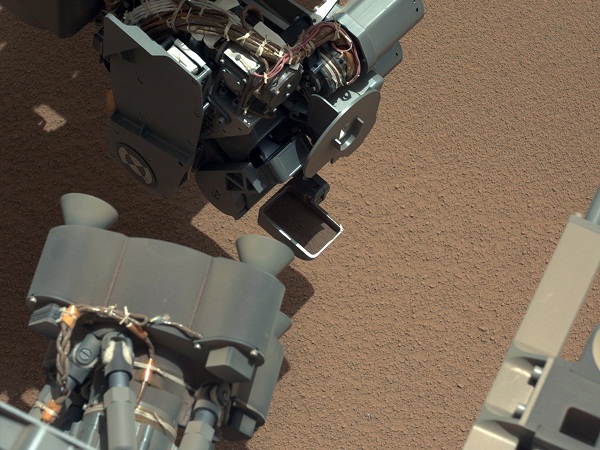Mars rover finds Earth-like rock

This image from the right Mast Camera (Mastcam) of NASA’s Mars rover Curiosity shows a scoop full of sand and dust lifted by the rover’s first use of the scoop on its robotic arm. In the foreground, near the bottom of the image, a bright object is visible on the ground. NASA says a small bright object detected on Mars is likely a piece of plastic from the Curiosity rover. The six-wheel spacecraft captured an image of the puzzling object Monday, October 8, 2012, after scooping up Martian sand and dust over the weekend. In a statement Tuesday, the space agency says the plastic bit that fell off the rover is “benign.” While plans are continuing to positively identify it, NASA says it is not “Martian material.” AP/NASA/JPL-Caltech/MSSS
WASHINGTON—A rock analyzed by the National Aeronautics and Space Administration’s (Nasa) Mars rover Curiosity has a surprising and more varied composition that resembles rare rocks from the bowels of our planet, the US space agency said on Thursday.
“This rock is a close match in chemical composition to an unusual but well-known type of igneous rock found in many volcanic provinces on Earth,” Curiosity coinvestigator Edward Stolper of the California Institute of Technology in Pasadena said in a statement.
“With only one Martian rock of this type, it is difficult to know whether the same processes were involved, but it is a reasonable place to start thinking about its origin.”
On Earth, rocks with similar compositions usually come from “processes in the planet’s mantle beneath the crust, from the crystallization of relatively water-rich magna at elevated pressure,” according to the Nasa statement.
Jake Matijevic
Curiosity, on the Red Planet since Aug. 6, used two instruments to study the football-sized rock, which is dubbed Jake Matijevic, or Jake for short.
One was the arm-mounted Alpha Particle X-Ray Spectrometer—known as APXS—and the other was the Chemistry and Camera (ChemCam) instrument.
“Jake is kind of an odd Martian rock,” said APXS principal investigator Ralf Gellert of the University of Guelph in Ontario, Canada. “It’s high in elements consistent with the mineral feldspar, and low in magnesium and iron.”
Nasa said the initial results were just a preview, noting that Curiosity also carries analytical laboratories inside the rover.
Next: Soil sample
Soon, it plans to analyze its first Martian soil sample.
“We used Curiosity’s first perfectly scooped sample for cleaning the interior surfaces of our 150-micron sample-processing chambers,” said Chris Roumeliotis, lead turret rover planner at Nasa’s Jet Propulsion Laboratory. “It’s our version of a Martian car wash.”
Nasa has also determined that a bright object observed on the ground near the robot several days ago was just a bit of plastic that does not jeopardize the rover’s operations.
Curiosity is on a two-year, $2.5-billion mission to investigate whether it is possible to live on Mars and to learn whether conditions there might have been able to support life in the past.














